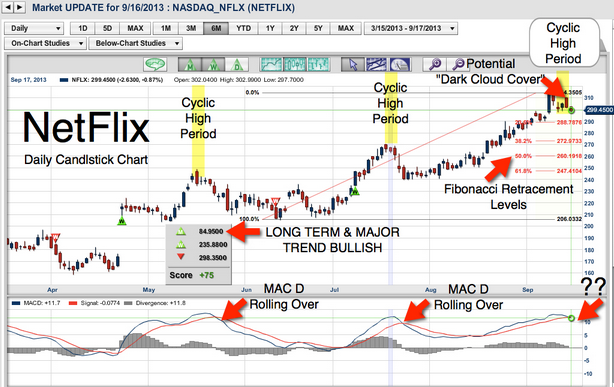
MarketClub is known for our "Trade Triangle" technology. However, if you have used other technical analysis indicators previously, you can use a combination of the studies and other techniques in conjunction with the "Trade Triangles" to further confirm trends.
W.D. Gann was a trader in the early 1900s who devised a unique and complex trading method that parallels some of these other theories. His technique is sometimes referred to as geometric because of his use of the mathematical properties of certain geometric figures and angles to predict price behavior. Gann had a cyclic view of market behavior and placed enormous emphasis on proportional relationships between price and time. He believed market events occurred at intervals that could be determined mathematically. And like Elliott, he believed the relationships he “discovered” reflected the natural law of the universe.
Gann calculated price retracements on percentages derived from dividing price action into eights, i.e. 2/8 = 25%, 4/8 – 50%, etc. He also included the Dow and Fibonacci retracements of 1/3 (33%) and 2/3 (67%) in his list of key percentages. He constructed support and resistance lines (Gann lines) based on varying ratios of time units to price units. His most important trend line, plotted at 45 degrees (up from a market bottom or down from a market top) represents one unit of time movement per one unit of price movement.
He also placed lines with other time/price ratios, like 1:2, 2:1, 1:3. 3:1, etc. The angle of these lines corresponds to the strength and speed of a trend. As long as pries stay above (or below, depending on the direction of the trend) the 45-degree line, the trend will continue. Once prices break that line, they will theoretically proceed to the next line of resistance, 1:2 or 1:3, for example, as the trend is played out.
Gann determined “anniversary dates” for timing market events based on the degrees of a circle (30, 60, 90, 180, 360 days) as well as periods of 12 months and 144 days (144 is the only square Fibonacci number). For example, when a market made a high or low, Gann looked for another significant price milestone 144 days or a year in the future.
He also predicted future support and resistance points using “cardinal squares.” Starting with a low price for a contract, he spiraled prices clockwise around it on a grid until the prices reached the current trading range. Prices that fell on the “cardinal cross,” the perpendicular lines equivalent to the X and Y axes of a graph, represented probable levels of future support and resistance.
Gann techniques are most effective when used together. Instances in which a trend reversal corresponds to a previously calculated retracement ratio, a cardinal square price, an anniversary date and the breaking of a trend line would represent important market cycles.
---
 You can learn more about the Gann Theory by visiting INO TV.
You can learn more about the Gann Theory by visiting INO TV.






